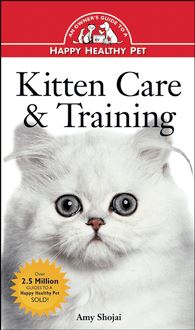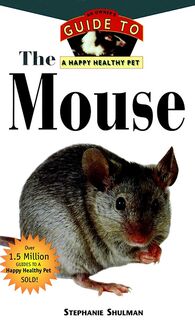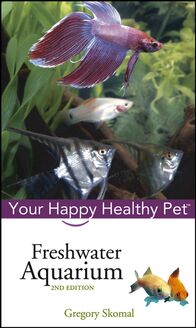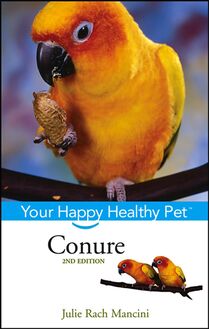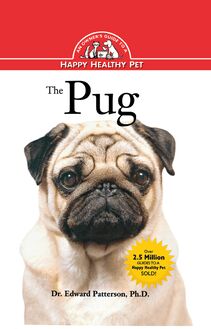The Rabbit , livre ebook
88
pages
English
Ebooks
2008
Vous pourrez modifier la taille du texte de cet ouvrage
Obtenez un accès à la bibliothèque pour le consulter en ligne En savoir plus
Découvre YouScribe en t'inscrivant gratuitement
Découvre YouScribe en t'inscrivant gratuitement
88
pages
English
Ebooks
2008
Vous pourrez modifier la taille du texte de cet ouvrage
Obtenez un accès à la bibliothèque pour le consulter en ligne En savoir plus
Publié par
Date de parution
05 mai 2008
Nombre de lectures
2
EAN13
9780470368008
Langue
English
Poids de l'ouvrage
1 Mo
PART ONE: Welcome to the World of the Rabbit.
1. History of the Rabbit.
2. Rabbits as Pets.
3. Rabbit Breeds.
PART TWO: Living with a Rabbit.
4. Bringing Bunny Home.
5. Indoor Rabbits.
6. Outdoor Rabbits.
7. Nutrition and Grooming.
8. Your Rabbit's Health.
PART THREE: Enjoying Your Rabbit.
9. Understanding Your Rabbit.
10. Fun with Bunny.
PART FOUR: Beyond the Basics.
11. Recommended Reading.
12. Resources.
Publié par
Date de parution
05 mai 2008
Nombre de lectures
2
EAN13
9780470368008
Langue
English
Poids de l'ouvrage
1 Mo
The
Rabbit
Howell Book House
Howell Book House A Simon Schuster Macmillan Company 1633 Broadway New York, NY 10019
Copyright 1996 by Howell Book House All rights reserved. No part of this book may be reproduced or transmitted in any form or by any means, electronic or mechanical, including photocopying, recording, or by any information storage and retrieval system, without permission in writing from the Publisher.
MACMILLAN is a registered trademark of Macmillan, Inc.
Library of Congress Cataloging-in-Publication Data
Pavia, Audrey The rabbit: an owner s guide to a happy healthy pet/by Audrey Pavia. p. cm. Includes bibliographical references.
ISBN 0-87605-489-0 (hardcover)
1. Rabbits as pets. I. Title SF453.P38 1996 96-21903 636 .9322-dc20 CIP
Manufactured in the United States of America 10 9 8 7 6 5 4 3 2 1
Series Director: Dominique DeVito Series Assistant Director: Ariel Cannon Book Design: Michele Laseau Cover Design: Iris Jeromnimon Illustration: Ryan Oldfather Photography:
Cover Photos by Ren e Stockdale (large) and Paulette Braun/Pets by Paulette (inset)
ARBA: 24, 26, 30, 36
Joan Balzarini: 31, 66, 74, 87, 94, 113
Paulette Braun/Pets by Paulette: 7, 15, 19, 25, 72, 73, 107
Adam Gaus: 22, 27, 28, 33
Audrey Pavia: 117
Cheryl Primeau: 49
Ren e Stockdale: 5, 11, 12, 18, 20, 21, 32, 38, 42, 44, 45, 46, 51, 52, 54, 56, 57, 59, 60, 61, 63, 64, 65, 67, 68, 71, 75, 77, 78, 80, 81, 82, 83, 86, 88, 89, 92, 93, 95, 98, 99, 102, 103, 104, 106, 108, 109, 110, 111
Faith Uridel: 14, 23, 29, 35, 84, 114, 115
Jean Wentworth: 6, 9
WB/Phototest: 9
Production Team: Kathleen Caulfield, Michelle Croninger, and Chris Van Camp
Contents
part one
Welcome to the World of the Rabbit
1 History of the Rabbit
2 Rabbits as Pets
3 Rabbit Breeds
part two
Living with a Rabbit
4 Bringing Bunny Home
5 Indoor Rabbits
6 Outdoor Rabbits
7 Nutrition and Grooming
8 Your Rabbit s Health
part three
Enjoying Your Rabbit
9 Understanding Your Rabbit
10 Fun with Bunny
part four
Beyond the Basics
11 Recommended Reading
12 Resources
part one
chapter 1
History
of the
Rabbit
Thousands of years ago, the rabbit was much like the adorable pet of today: its ears were long, its nose twitched incessantly, and it loved to groom its fur to perfection. But in other ways, the rabbit of antiquity and the rabbit of today are worlds apart.
The record of the rabbit s history begins with the earliest known rabbit fossils, which were found in China and Mongolia, and which date back nearly sixty-five million years to the Paleocene period. In North America, the oldest rabbit fossils are from the Oligocene period thirty-seven million years ago. These ancient species were the evolutionary forebears of today s wild rabbits; modern rabbits differ very little from today s fossil pictures of ancient rabbits.
Rabbits and Humans
The first signs of humankind s relationship with the rabbit appear in Spanish cave paintings dating from the Stone Age. Artists painted rabbits and hares, along with other animals, on the walls of caves during the Pleistocene period. During this time, the rabbit migrated down to southwestern Europe in an effort to escape the great cold of the Ice Age.
The descendants of the Ice Age rabbits were domesticated near the Mediterranean region in Europe and Africa around 600 B.C., when they were used for their meat and fur. They were traded extensively first by the Phoenicians and then later by other cultures, eventually spreading to America, Australia and New Zealand.
The rabbit s relationship with humans was not always as congenial as it is today .
Rabbit Overpopulation
Like most domesticated species in history, rabbits eventually escaped their captors or were deliberately set free, and soon populated the land. Because rabbits reproduce with such frequency, the natural predator/prey balance in these areas was upset; uncontrolled by natural enemies, rabbits were able to procreate with great rapidity. Feral rabbits were soon so great in number that they began to overgraze the land.
In the 1800s, feral rabbits in Australia multiplied to the point of overrunning the land. Crops were destroyed, and farmers waged a war on rabbits. Shooting, trapping and relentless hunting were practiced in an effort to rid the continent of an overabundance of rabbits.
Then, in the 1950s, biological warfare against rabbits was instituted. Scientists deliberately spread a virus called myxomatosis among feral rabbit populations in an effort to destroy them. This virus was initially successful and appeared to decimate the rabbit population. It later became evident, however, that some rabbits had developed a resistance to it. These immune rabbits eventually recolonized the areas, and the disease therefore had little long-term effect. Periodically, myxomatosis epidemics still recur in wild rabbit populations and sometimes among domestic rabbits, but the cycle of immunity repeats itself in the wild, and populations are restored.
The Rabbit Today
Until the Middle Ages, rabbits were considered a strictly agricultural commodity and were not raised as pets. However, during the fifth century, monasteries in France began keeping rabbits just for the enjoyment of creating different colored coats.
Rabbits have long been the subject of literature and other works or art .
In the 1700s, individuals began keeping rabbits as pets, and in the mid-1800s, rabbit owners who had originally used their animals only for food and fur started to develop specific breeds. Shortly thereafter, these owners began showing their rabbits at competitions. The hobby of showing and breeding rabbits developed unregulated until the mid-1930s when the British Rabbit Council was formed. The goal of the council was to govern the fancy by supervising various rabbit clubs and registering rabbits throughout Great Britain.
The domestic rabbit population in the United States was probably first introduced by early explorers, although there is little written about the animal in America before the late 1800s. Rabbits were used primarily as food here until breeding and showing caught on late in the nineteenth century.
Once showing and breeding caught on as an activity in the early 1900s, the American Rabbit Breeders Association (ARBA) was founded to promote, encourage and develop the rabbit industry in the United States. ARBA is still the governing body for the rabbit fancy in this country. (See Chapter 10 for more on ARBA.)
RABBIT LORE
Throughout its history, the rabbit has had a notable affect on humankind. Aside from viewing the rabbit as a source of food and warmth, many cultures have also praised the rabbit for its swiftness and wit.
The most recognizable folktale involving a lagomorph is the story of the tortoise and the hare. Originally a fable from Africa, the story was later adopted and made famous by Aesop. The moral of the fable was designed to convince children that, regardless of how confident they are, they should not cut corners in life, as the hare did.
Native American peoples have revered the rabbit throughout history, and some tribes still view it as an important part of their culture. The Algonquins believe that the Great Hare rebuilt the world after an enormous flood, repopulating the world with his offspring. Consequently, according to the story, all humankind is related to the hare.
Rabbits vs. Hares
To the average person, there is not much difference between a rabbit and a hare. Scientifically they do have many things in common; both rabbits and hares belong to the order Lagomorpha , and the family, Leporidae . Since both are lagomorphs, they are similar in appearance. However, most people don t realize that there are considerable differences between rabbits and hares and that the two are actually classified as two different species.
The hare is generally the larger of the two, with longer legs and torso. While a rabbit s young are born hairless and with their eyes closed, baby hares have fur and are born with their eyes open. There are also considerable behavioral differences between the two species. Rabbits are highly sociable creatures and live underground in community groups when in the wild. Hares, on the other hand, are solitary creatures who prefer to live alone above ground. Because of this unsociable nature, hares are rarely appropriate as pets. In fact, unlike the rabbit, there is no domesticated species of hare. Some examples of wild hares are the Snowshoe hare, the Arctic hare and the jackrabbit (a misnomer). Wild rabbits include the cottontail, the brush rabbit and the European rabbit.
R ABBITS , H ARES AND R ODENTS
Both the rabbit and the hare were once thought of as rodents because of their long front teeth. Scientists later discovered that while rabbits and hares share a common prehistoric ancestor with rodents, rabbits and hares are from a completely different order. The distinction between rodents and lagomorphs is small but noteworthy. While rodents have four front teeth, rabbits and hares have one more pair of incisors. Rabbits and hares also chew their food differently than rodents.
While rabbits and hares share much in common, they actually belong to two different species .
Rabbits in Popular Culture
The rabbit is a favorite subject in contemporary literature, particularly in fiction written for children. The Tale of Peter Rabbit, the story of a disobedient young bunny named Peter, has been read and loved by children around the world. The names of the characters in this book by Beatrix Potter have become synonymous with rabbits everywhere: Peter, Flopsy, Mopsy and Cottontail.
Bugs Bunny is America s most famous rabbit .
Another book about rabbits, Watership Down , by Richard Adams, has gained great notoriety, and deservedly so. Using natural rabbit behaviors to create a story about a group of rabbits trying to find a new home in the English countryside, Adams prod


